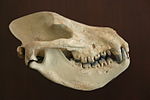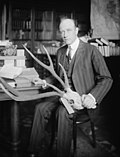flat mandibular fossa suggest that Andrewsarchus likely had a fairly weak bite force. The holotype of Andrewsarchus mongoliensis is a mostly complete cranium...
29 KB (2,703 words) - 12:57, 10 January 2025
"stem-whippomorphs") include such taxa as the family Entelodontidae and the genus Andrewsarchus. "A 'consensus cladogram' for artiodactyls". Archived from the original...
3 KB (219 words) - 04:06, 3 December 2023
the deletion of Andrewsarchus, which has often been included within the mesonychians. One possible conclusion is that Andrewsarchus has been incorrectly...
13 KB (1,533 words) - 08:43, 21 November 2024
to generate the proposal that Andrewsarchus was the largest predatory land mammal that ever lived. Since Andrewsarchus is known only from a single isolated...
7 KB (662 words) - 21:40, 8 January 2025
which, by that time, had become almost fully aquatic. Mammals like Andrewsarchus were at the top of the food-chain. The Late Eocene saw the rebirth of...
36 KB (3,770 words) - 09:00, 10 December 2024
on whether the giant enigmatic mammal Andrewsarchus is included, and it has been suggested that Andrewsarchus is in fact an entelodont or close relative...
31 KB (3,722 words) - 07:07, 15 December 2024
polyphyletic) Mesonychia (natural clade, though several members, such as genus Andrewsarchus, are now thought to belong in other groups) Superorder: Laurasiatheria...
16 KB (1,538 words) - 13:22, 5 January 2025
Cambridge University Press, Cambridge. Artistic reconstruction of Sarkastodon, shown waiting for Andrewsarchus to finish eating from a dead brontothere....
5 KB (400 words) - 20:23, 25 February 2024
savanna began to predominate much of the landscape, and mammals such as Andrewsarchus rose up to become the largest known terrestrial predatory mammal ever...
147 KB (15,855 words) - 05:19, 31 December 2024
powerful jaws, like those of the unrelated placentalians Hyaenodon and Andrewsarchus, for crushing bones. Borhyaenids grew up to an average of 5 to 6 feet...
4 KB (416 words) - 00:24, 21 December 2024
suiform model. Instead, they suggest that the family lies close to Andrewsarchus, anthracotheres, hippopotamuses and whales, within Cetancodontamorpha...
44 KB (4,560 words) - 12:43, 10 January 2025
†Doliochoeridae Clade Cetruminantia Clade Cetancodontamorpha Genus †Andrewsarchus? Family †Entelodontidae Suborder Whippomorpha Family †Raoellidae Superfamily...
65 KB (6,552 words) - 20:19, 7 January 2025
sent back to the museum, arriving on December 19. The fossil species Andrewsarchus was named after him. Andrews, along with Henry Fairfield Osborn, was...
14 KB (1,490 words) - 01:15, 5 December 2024
Cetancodontamorpha, which also includes the extinct entelodonts and Andrewsarchus. The name Whippomorpha is a combination of English (wh[ale] + hippo[potamus])...
31 KB (3,258 words) - 09:37, 6 November 2024
Beasts – Evidence – Programme 2 – Andrewsarchus Archived 2013-05-10 at the Wayback Machine. ABC Osborn, H. F. Andrewsarchus, giant mesonychid of Mongolia...
81 KB (9,080 words) - 09:47, 30 December 2024
anthracotheres are part of a clade that also consists of entelodonts (and even Andrewsarchus) and that is a sister clade to other cetancodonts, with Siamotherium...
9 KB (956 words) - 09:02, 14 August 2024
large bite marks on Apatosaurine vertebrae. The only known skull of Andrewsarchus mongoliensis. A display of various species of ground sloths including...
221 KB (20,527 words) - 14:14, 15 January 2025
Mongolia was the home of many Paleogene mammals with Sarkastodon and Andrewsarchus being the most prominent of them. Homo erectus possibly inhabited Mongolia...
126 KB (16,838 words) - 00:00, 16 December 2024
different animals in different ways. On land, the giant predatory animal Andrewsarchus is driven to the beach to feed on sea turtles and a herd of Embolotherium...
37 KB (3,474 words) - 17:16, 23 December 2024
of Team EX. Ando Andrew (安藤アンドリュー) Voiced by: Taiten Kusunoki A male Andrewsarchus that is a member of Team EX. Yangyang (ヤンヤン) Voiced by: Satomi Arai...
57 KB (3,489 words) - 21:35, 24 November 2024
squid"); Thalattoarchon ("sea ruler"); Archosaur ("ruling lizard"); Andrewsarchus ("ruler of Andrews") archaeo-: Pronunciation: /arkiːɒ/, /arkiːoʊ/ ....
41 KB (3,864 words) - 08:20, 15 January 2025
manatees and dugongs. Cast of Uintatherium anceps skull Reconstruction of Andrewsarchus Basilosaurus, an Eocene whale Pakicetus, Ypresian Moeritherium, a basal...
107 KB (11,667 words) - 20:48, 9 January 2025
performed a phylogenetic analysis that recovered it in a polytomy with Andrewsarchus and Achaenodon. Erlianhyus is known from a partial maxilla that preserves...
3 KB (251 words) - 20:33, 6 January 2025
mammalian carnivores from several eutherian groups (the artiodactyl Andrewsarchus – formerly considered a mesonychid, the oxyaenid Sarkastodon, and the...
78 KB (8,080 words) - 19:05, 9 January 2025
is consistent with many molecular studies. Some studies have found Andrewsarchus, once considered a mesonychid, to form the sister group to the clade...
9 KB (858 words) - 11:35, 19 October 2024
Thalassocnus, Thylacoleo, Andrewsarchus, Pseudaelurus, Dimetrodon, Homo floresiensis, Amebelodon Doedicurus (1), Andrewsarchus (4), Dimetrodon (3), Amebelodon...
44 KB (2,245 words) - 09:04, 23 September 2024
American Museum Novitates (104). Osborn, H. F. (11 November 1924). "Andrewsarchus, giant mesonychid of Mongolia". American Museum Novitates (146). American...
8 KB (310 words) - 02:11, 27 June 2024
The expedition also lead to the discovery of the only known skull of Andrewsarchus. List of fossil sites Irdin Manha Beds (1930 AMNH Eudinoceras site)...
30 KB (1,215 words) - 15:53, 1 November 2024
7 m (12 ft) long and 1.77 m (5.8 ft) high at the shoulder. The huge Andrewsarchus from the Eocene of Inner Mongolia had skull 83.4 cm (32.8 in) long though...
391 KB (40,795 words) - 06:28, 6 January 2025
thunked helter-skelter into these boy books, whether Roarke’s Drift, Andrewsarchus Mongoliensis (a giant wolf-like animal that may have eaten beached whales)...
3 KB (333 words) - 09:47, 6 September 2023



















